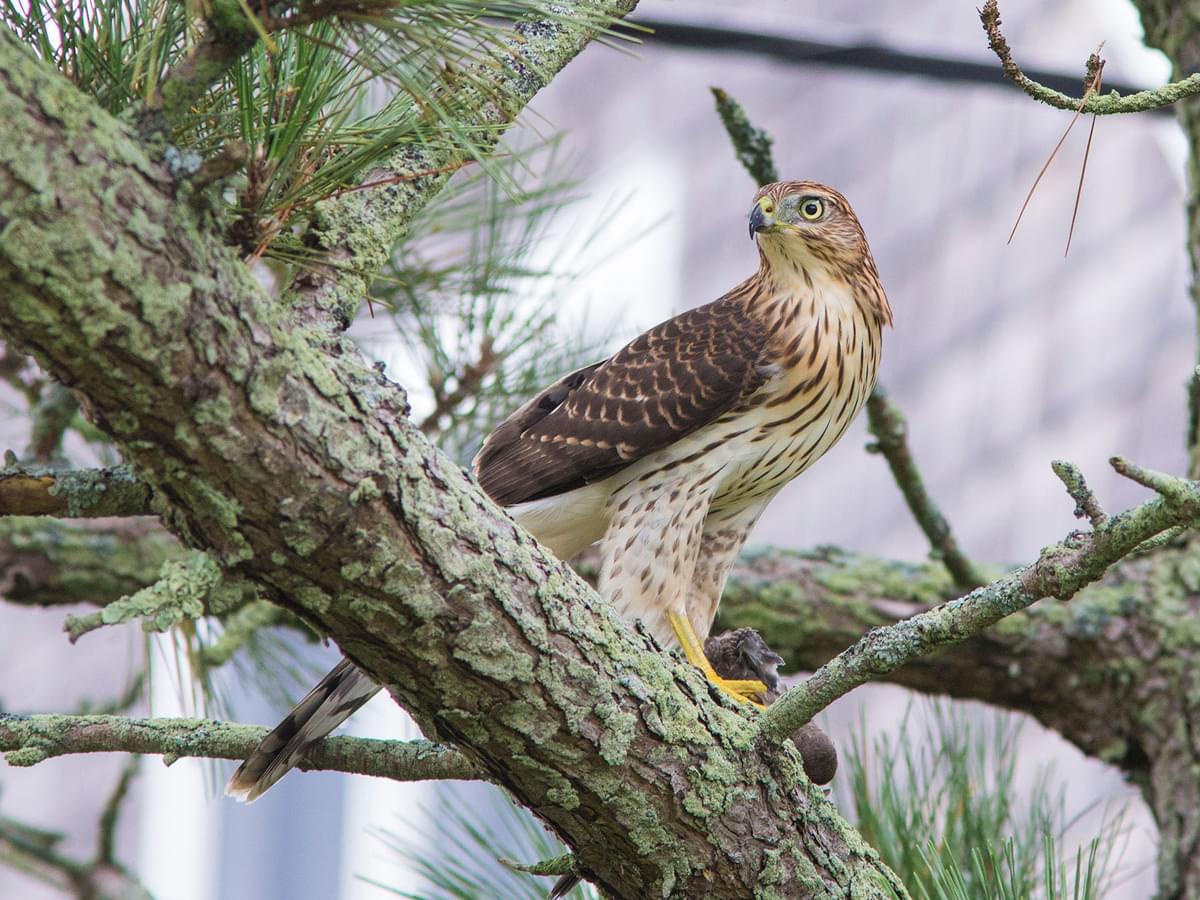Cooper's Hawk: Range, Habitat + FAQs
Last updated: 11 February 2023

The Cooper’s hawk is a medium-sized raptor. They are widespread throughout their range, which includes much of North America. In this article, we'll go into the typical habitat of a Cooper's hawk, along with their distribution range across the US and Canada.
Cooper’s hawks breed within a variety of forest habitats in the contiguous United States and southern Canada. Many individuals remain in or near their breeding territories during winter. However, populations in the northern third of their range migrate south, some as far as Mexico and Costa Rica.
This highly adaptable species has been expanding its range in recent years. They are not only pushing farther north and south but becoming more abundant in urban and suburban areas.
We will discuss the Cooper’s hawk range and habitat in more detail throughout the article. Read on to discover more!

Cooper's hawk perched on a garden fence
Distribution Range
The Cooper’s hawk is distributed throughout the contiguous United States, southeastern Canada, and Mexico. Populations breed in Canada and the US, but generally, migrate away from the Canadian Territories and the northernmost states during winter.
Mexico is primarily an overwintering range for the Cooper’s Hawk. They are found throughout most of the country, south to Costa Rica, and possibly in Panama, Cuba, and Colombia.
Over the past 15 years, this species has expanded its range extensively, particularly farther north in Canada and farther south in Mexico.
Where do Cooper's Hawks live in the US?
Cooper’s hawks are present throughout the entirety of the contiguous United States. Except for the northern half of Maine, this hawk species is common in almost every forested habitat across the country. They are even adapting to nesting in urban and suburban environments.

Cooper's hawks have expanded their range significantly over the past 15 years, particularly northward
What states do Cooper's Hawks live in?
The lower 48 states in America are all home to the Cooper’s hawk. The only two states in the US where this species is not found are Alaska and Hawaii.
Where do Cooper's Hawks live in Canada?
In Canada, the Cooper’s hawk is a breeding resident in central British Columbia, Alberta, southern Manitoba, southern Ontario, and southern Quebec. The species also potentially breeds in southern New Brunswick.

Male Cooper's hawk, perched in a tree on the lookout for prey
Habitat
The Cooper’s hawk has an extensive habitat range. They occur throughout coniferous, deciduous, and mixed-conifer forests within their territory. The hawk is also common in riparian habitats. Nests are typically built within mixed-conifer forests, in mature trees.
This species happens to be reasonably tolerant of human disturbance. In fact, they have begun nesting in urban and suburban areas.
Spotting, seasonality and movements
How rare is it to see a Cooper's Hawk?
Cooper's hawks are not rare, but they are swift fliers and experts at blending in with their surroundings. To spot one, you generally have to be on the lookout. They spend most of their time in forests, which can make sightings difficult.
Where is the best place to see Cooper's Hawks?
The best place to see a Cooper’s hawk is in a forest or forest edge habitat. These are the bird’s preferred places to hunt. Although this species occasionally hunts in open fields and meadows, they do so less frequently than other larger raptors.

Juvenile Cooper's hawk launching from a branch, on the hunt for prey
What time do Cooper's Hawks come out?
Cooper’s hawks are diurnal, meaning they are most active during the day. About 20% of their time is usually spent hunting. The remainder of the day is divided between perching, flying, and caring for young (if it is nesting season).
Do Cooper's Hawks stay in one place?
Some populations of Cooper’s hawks stay in one place, while others are migratory. Generally, birds that breed in Canada and the northern US migrate farther south for winter. However, there are a few exceptions.
Breeding adults around Vancouver typically remain on their breeding territories year-round. Yet, some birds in the southwestern United States are not permanent residents - they migrate south to Mexico, and, in some cases, slightly farther north.

Cooper's hawk perched in a tree in the backyard, watching unsuspecting birds at the feeder
Where do Cooper's Hawks live in the winter?
Many Cooper’s hawks are permanent residents, remaining in or near their breeding territories in winter - particularly those in the lower three-fourths of the United States. However, some individuals migrate south to overwinter in Mexico and Costa Rica.
Southward migrations typically begin in late August and run through early November. Overwintering habitat is also much the same as the breeding season.
How do Cooper's Hawks survive winter?
Cooper’s hawks survive extremely harsh winters by migrating out of the northernmost regions of their range. That is not to say they avoid harsh weather entirely, as the hawks are still present in the Midwest and western states.
However, the Cooper's hawk is a skilled hunter. They choose territories with abundant food sources so that they can hunt frequently enough to keep up their energy and stay warm.
Where do Cooper's Hawks live in the summer?
During summer, the Cooper’s hawk is widespread throughout the forests of the United States and southern Canada. The only part of its range this species is not present in is Mexico. Individuals that migrate begin their flights back north in March and continue through May.






